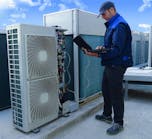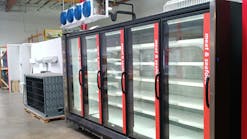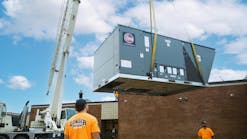Improperly heated or cooled buildings can cause a host of problems, including a loss of employee productivity and computer malfunctions. Mechanical failure of commercial HVAC systems can result in thousands of dollars in damages. These incidents, and the majority of service calls can be prevented through proper maintenance. Typically, packaged units are located on building rooftops, making it difficult to see or hear small changes which indicate the need for a service call. (Out of sight out of mind.) Properly maintained equipment can also lower the overall annual operating/repair costs. The following maintenance procedures will keep your commercial HVAC equipment in proper operating condition.
Inspect air filters every 3 to 4 weeks with replacement or cleaning
• Dirty filters block normal air flow and significantly reduce a system's efficiency. With normal air flow obstructed, air that bypasses the filter may carry dirt directly into the evaporator coil and impair the coil's heat-absorbing capacity.
• Keeping the filter clean can lower your air conditioner's energy consumption by 5%–15%. In cooling mode, if there isn’t enough air over the indoor coil, the coil temperature drops. When it drops below the freezing point, ice forms on the coil, which further reduces the airflow and coil temperature. The compressor is a pump which is designed to pump a vapor. As airflow through the indoor coil drops, there isn't enough heat being removed from the air passing over the coil to vaporize the liquid refrigerant. Thus, instead of receiving a vapor, the compressor receives liquid refrigerant; this is called "liquid slugging.”
As liquids are not compressible, cylinder pressure exceeds the design limits. As a result the valves, pistons, or other internal components are destroyed. The unit started out only requiring a filter replacement, and now it needs a new compressor. In heating mode, low airflow causes the heat exchanger to overheat. At higher temperatures, the heat exchanger oxidizes and its life-span is reduced, or it cracks and breaks. In either case, it makes more sense to replace air filters regularly than to replace a heat exchanger.
Inspect the blower wheel housing and motor
• The blower wheel houseing and motor are integral parts of the air handling system as they draw fresh air into buildings. Dirty blower wheels can decrease the life of the system by reducing airflow, causing the coils to freeze and the compressor to fail, and increase the cost of running the unit. Dirty blower wheels can become unbalanced, damaged, and put stress on the motor. This can sometimes be indicated by increased sound when the unit is in operation.
Good filtration helps keep dirt out of the fan, but an annual visual inspection still makes sense. If impeller blades are coated with dirt, fan efficiency will suffer.
Inspect belts, pulleys, bearings, and lubricate motors and bearings as needed
• Inspect belts for cracking, fraying, and proper tension. Loose belts can cause slipping and result in intermittent cooling and heating. Excessive tension can cause stress on the motor and bearings. Worn drive belts due to belt slippage wear a groove in the pulleys so that when a new belt is installed the new belt will be ruined in a short time. • Bearings that aren’t lubricated regularly will overheat and seize. When this occurs, the bearings fall apart, and the blower wheel, shaft, and housing are destroyed.
Change drive belt annually
• Blower belts are a regular wear and tear item and should be replaced annually. Occasionally extensive equipment operation can necessitate additional belt replacement. Inspect and/or clean indoor and outdoor coils
• If the finned surfaces of the outdoor coils are fouled with dirt, the ability of these coils to transfer heat is diminished and the airflow through the condenser coil will be reduced. When the ability to transfer heat is reduced, the operating temperatures and pressures of the unit increase. A unit may stop operating due to the reduced heat transfer capability. The operating temperatures and pressures within the unit exceed the manufacturer's safe limit, and the unit shuts down. If the unit doesn’t exceed the manufacturer's limits enough to cause it to shut down, it will continue to run at reduced capacity and efficiency, and have an increased rate of wear due to the increased work load. Inspect the indoor drain pan and condensate drain lines
• If the system has an auxiliary drain pan and line, they should be inspected as well. Service should include cleaning if required. Clogged drain channels prevent a unit from reducing humidity.
Inspect economizer annually
• Perform an annual cycle inspection to ensure the actuator, dampers and temperature sensors are operating correctly. Check the ventilation settings and dampers located throughout the ductwork system. In the event of cool outside air, the quantity of outside air is increased and the quantity of re-circulated air is reduced to provide the required supply air temperature. This way cooling by means of refrigeration equipment is avoided altogether at certain times of year and often at night. Inspect all electrical wiring, connections, and relay points
• It’s important to check the high and low voltage electrical connections. A loose electrical connection can cause big problems and be a safety issue. The inspection will include locating loose wiring or loose electrical connections and corroded or frayed wires. A loose electrical connection could start a fire in a commercial building.
Check for voltage imbalances
• Electrical equipment, especially motors and their controllers, will not operate reliably on unbalanced voltages in a 3-phase system. Generally, the difference between the highest and the lowest voltages should not exceed 4% of the lowest voltage. Greater imbalances may cause overheating of components; especially motors; and intermittent shutdown of motor controllers. Motors operated on unbalanced voltages will overheat, and many overload relays can't sense the overheating. In addition, many solid-state motor controllers and inverters include components that are especially sensitive to voltage imbalances.
Conduct amperage checks annually
• If the equipment is drawing greater than 10% of the equipment’s rating the overloading could be a mechanical problem, like worn bearings, worn rods, etc. High amperage could also be caused by high suction pressures indicating a refrigeration problem.
• Perform a visual inspection during each maintenance visit.
• Loose parts could cause excessive wear, failure of the equipment and possible expensive damage to the unit. You should also check fan blades for chips or cracks that may cause noise or vibration. Inspect flue gas passages, burners, heat exchangers, coupling boxes, and inducer assembly
• The heat exchanger is the most critical component of your unit, by far. If the heat exchanger either rusts or cracks, it could create a serious health and safety problem. Combustible byproducts can possibly escape through these cracks and then into the buildings air supply. This could result in serious illness and quite possibly, death. It may be possible that you have to dismantle a portion of the unit to inspect the heat exchanger more thoroughly. Check the inducer motor to make sure it’s operating properly, and check the inducer wheel for excessive rusting, missing blades, and balance. Inspect gas burners, igniter, and combustion section (gas heat only)
• Ignition problems include popping, roaring noises, smoking, vibration, and flame rollout. A blue color in the flames instead of a yellow color could indicate a problem with that particular burner. Inspecting these parts is necessary to insure your unit’s safe operation and efficiency. A test for gas leaks should also be preformed.
Perform overall operational check seasonally
• This includes checking and adjusting the refrigerant charge and checking the unit’s gas pressure per manufacturer’s guidelines.
• Once all of the inspections have been made, the necessary repairs and/or adjustments should be performed. Now that we’ve given an overview of a proper maintenance inspection, we must remind you that after performing maintenance and/or repair, make sure all panels are fastened securely in place.
Using hand tools to remove and reinstall these small screws can be exasperating, which explains why many panels have only one or two screws left in place after a few service calls. But loose panels cause a leaky unit, which in turn means valuable chilled air is spilling onto the roof. Don’t over tighten or strip the screws. Technicians should keep a bag of screws on hand to replace missing ones, including oversized screws for stripped holes. The cost of a regular maintenance agreement is clearly more favorable when you think of all the potential repair/replacement costs.
Darryl Bowens is branch manager at CroppMetcalfe Mechanical, Fairfax, VA. He has12 years with CroppMetcalfe and 25 years in the HVAC industry. Bernie Sisson is a service manager at CroppMetcalfe Mechanical, Fairfax, VA. He has been with the company for about two years and has 29 years experience in the HVAC industry.








